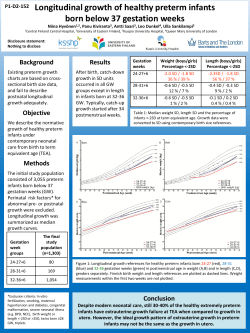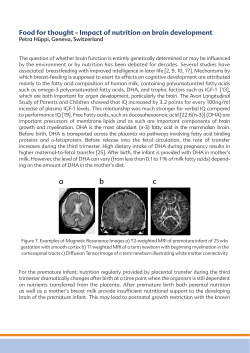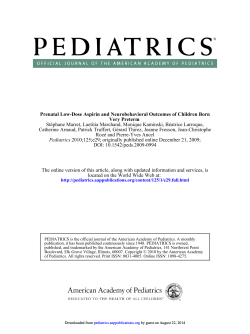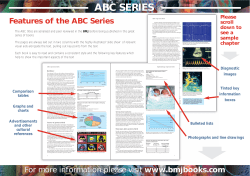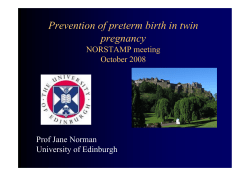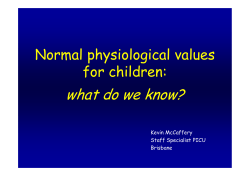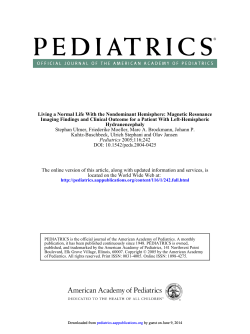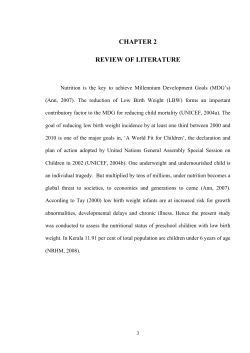
Long-term Neurodevelopmental Outcomes of Interdisciplinary Institute: Premature and High-risk Infants:
Long-term Neurodevelopmental Outcomes of Very Preterm and Very Low Birth Weight Infants Interdisciplinary Institute: Premature and High-risk Infants: Transitioning Home from the NICU Deborah Campbell, MD, FAAP November 1, 2013 montekids.org Faculty Disclosure In the past 12 months, I have not had any significant financial interest or relationship with the manufacturer(s) of the products or providers of the service(s) that will be discussed in this presentation. This presentation will not include discussion of pharmaceuticals or devices that have not been approved by the FDA. Objectives Describe the later childhood, adolescent and adult health and functional outcomes for PT and very low birth weight NICU graduates Describe the neurodevelopmental outcomes over the life course Recognize the factors that affect neurodevelopmental outcome in this group of children What are the Survival Rates and Outcomes for Preterm Infants? Definitions Low birth weight < 2500g or 5lb 8oz 8.2% of live births Very low birth weight < 1500g or 3lb 5oz 1.5% of LB Extremely low birth weight < 1000g or 1lb 3oz 0.8% of LB Prematurity Birth at less than 37 weeks’ gestation Extreme PT - < 32 wks’ Moderate PT – 32- 336/7 wks’ Late PT - 340/7 -366/7 wks’ Multiple births ~ 3% of all live births Greater tendency to be high risk Twin birth rate ~ 27/1000 50% born preterm or LBW Triplet birth rate 1.7/1000 (natural rate 1/8000) Majority born preterm or LBW Postmenstrual age (PMA) or corrected gestational age (CGA): age following conception in wks (used after baby is born) Changing Trends in LBW and Preterm Birth: 1990-2011 < 37 w: 11.73% (prelim 2012: 11.54%) 34-36 w: 8.28% 32-33 w: 1.52% 28-31 w: 1.2% < 28 w: 0.73% LBW: 8.1% VLBW: 1.4% ELBW: 0.69% US Births less than 39 weeks’ gestation: 1990, 2006-2011 Colorado PT: 11.7% (10.4-16.5%) W: 10.8% B: 16.5% AI/NA: 13.5% A/PI: 10.4% H: 11.7% Early PT: 3.4% Late PT: 8.3% Survival Rates to Hospital Discharge: 22-25 weeks’ Gestation (Haward M, et al. Clin Perinatol 2011; 38:479-492) Cohort 22w (%) 23w (%) 24w (%) 25w (%) Live births (LB) 6 26 55 72 LB 5 33 61 - 1996-97 Population-based (LB+SB) 1 17 44 68 1999-2000 Population-based 0 6 29 56 EPICure (UK, Ire) 1995 2006 Population-based LB/NICU care 1 1/7 11 15/22 26 36/42 56 62/66 EPIPAGE (Fr) 1997 Population-based 0 0 13 50 EXPRESS (Sweden) 2004-2007 LB Population-based Norwegian Infant Study Switzerland 1999-2000 Admit to NICU Population-based 2000-2004 Population-based 12 7 0 0 0 54 34 39 16 5 71 60 60 44 30 82 73 80 66 50 Japan (single) 1991-2006 LB 25 47 50 2003 LB 36 75 75 NICHD VON Canadian Neonatal Network EPIBel Japan (multi-center) Year 2003-2007 2009 Denominator NICHD: Rates Death and Severe Neurodevelopmental Disability NICHD Neurodevelopmental Outcomes: ELBW Infants (1993-1998 v 2003-2007) Includes deaths within 12 hours of birth Outcome Survival Mod.-severe CP MDI < 70 PDI < 70 Blindness Hearing loss NDI 22-26 Weeks 27-32 Weeks 61% 10% 37% 26% 1% 1.8% 45% 86% 6% 23% 17% 0.4% 1.8% 28% 22-26 w 27-28 w 60.3% 90.2% Vohr et al. Pediatrics 2005; 116:635-643; Stoll, et al. Pediatrics 2010; 126:443-56 NICHD Neonatal Outcomes: Extremely Preterm < 25 weeks, 401-1000 g, born 1993-2009 % Survival 1993-2009* 1999-2001+ 2001-2004+ 2003-2007** 73.5 35 32 51.2 (excl w/n death 12h) (incl deaths w/n 12 h) (deaths w/n 12 h) (incl deaths w/n 12 h) BPD 59.1 61.1 Gr 3/4 IVH 20.8 16.5 Mod-severe CP 9.6 11 15 MDI < 70 40.1 44.9 51 PDI < 70 28.4 27.9 34.9 Blind 1.8 2 2.2 Hearing loss 2.9 2 4.3 NDI 42.5 50.1 58.7 *Carlo, et al. JAMA 2011; +Hintz, et al. Pediatrics 2011; **Stoll, et al. Pediatrics 2011 Mortality and Neonatal Morbidity: 501-1500 grams VON 2000-2009 (Hobar, et al. Pediatrics 2012; 129:1019-1026) Death + > 1 neonatal morbidity Morbidity N= 669 hospitals 335,806 VLBW neonates Mortality Postdischarge Outcomes are Associated with Major Neonatal Complications Brain injury: Grade 3 or 4 intraventricular hemorrhage (IVH) and periventricular leukomalacia (PVL); abnormal cranial sonogram (Hintz, et al. Pediatrics 2011; Bassler, et al, Pediatrics 2009; Carlo, et al, NEJM 2011) Bronchopulmonary dysplasia (NICHD; Schlapbach, et al. Acta Paed 2010) Severe retinopathy of prematurity (NICHD NRN studies) Necrotizing enterocolitis (NEC)/Sepsis (Schlapbach, et al. Ped 2011) NEC requiring surgery – poorer ND outcomes (Martin, et al. J Ped 2010 [associated bacteremia increases risk]) Emerging evidence Effects of > 2 anesthesia exposures and LD (Flick, et al. Ped 2011) Male gender (disability, cognitive delay, hearing loss, cranial US abnlty; CLD) (Peacock, et al. Ped Res 2012; NICHD NRN studies) Impact of Mechanical Ventilation and Other Risk Factors on Neurodevelopmental Outcome Adverse outcome defined as CP or Bayley MDI/PDI < 70 Risk Factor OR 95% CI Chorioamnionitis 1.4 0.5-4.0 Preeclampsia 1.4 0.5-4.0 Poor postnatal growth 1.9 1.3-2.9 Any mechanical ventilation 3.0 1.2-7.5 Bronchopulmonary dysplasia 3.8 1.1-11.1 Schlapbach, et al. Acta Paed 2010; 99:1504-1509 Injurious Ventilation “Gentle Ventilation” Epigenetics Stress [Catecholamines/Steroids] Immune responses Inflammatory Mediators MODS, multiple-organ system dysfunction syndrome Early lung injury, LPS, oxidant stress MODS Slide courtesy of Kurt Albertine, PhD Poor Weight Gain Increases Odds for Poor Outcomes ELBW infants, in-hospital growth: 12.0 vs 21.2 g/kg/day Cerebral palsy 8.00 (2.07–30.78) Bayley MDI <70 2.25 (1.03–4.93) Neurodevelopmental Impairment 0.2 MDI=Mental Development Index Ehrenkranz RA, et al. Pediatrics 2006;117:1253-61. 2.53 (1.27–5.03) 10.0 1.0 Odds Ratio (95% Confidence Interval) 50.0 Outcomes at 18-22 Months Corrected Age by Weight Gain Quartile (Ehrenkrantz, Pediatrics 2006) Outcome Quartile 1 (< 25%) 21 Quartile 4 (> 75%) 6 <.01 Abnormal ND 30 14 <.01 MDI < 70 39 21 <.01 PDI < 70 35 14 <.001 HC < 10% 31 22 .09 Rehospitalized 63 45 <.01 CP P Summary of Neurodevelopmental outcomes in appropriate-forgestational-age (AGA) and small-for-gestational-age (SGA) Infants who attained adequate v delayed extrauterine growth* Neurodevelopmental outcomes in subgroups of VLBW premature infants AGA Adequate catch-up growth Good neurodevelopmental outcome [PDI: 101.7 (14.7)] SGA Good neurodevelopmental outcome (similar to AGA with adequate catch-up growth [PDI: 101.8 (14.5)] Catch - up Delayed extrauterine growth (EUGR) Decreased mental and motor function [PDI: 94.9 (22.9)] Decreased motor function [PDI: 89.9 (17.4)] Catch - down VLBW, very low birthweight *9 and 24 months Latal-Hajnal, et al. J Pediatr 2003;143(2):163-70 montekids.org Neurodevelopmental Domains Affected Cognitive deficits Motor deficits Gross motor – developmental coordination disorder (16%) DCD associated w/ poorer academic performance (Roberts, DMCN 2011) Fine motor (71%) Cerebral palsy Sensory impairments Vision: visual-motor integration /spatial skills (10-20%) Hearing Behavioral and psychological problems Minor Neurodevelopmental Difficulties: High prevalence, low severity dysfunction Cognitive Mean IQ 8-14 points lower than FT Borderline intelligence – IQ 70-84 750-1500 g (20%); < 750 g (33%) < 1000 g (22%) [Gargus, et al. Pediatrics 2009] Learning deficits 45% - 65% v. 11% FT Reading, comprehension, written output, abstract thinking, math skills Memory tasks and processing speed Minor Neurodevelopmental Difficulties: High prevalence, low severity dysfunction ADHD, behavioral social problems Executive function deficits Planning Organizing Problem solving Working memory – retrieval Inhibition Attention Related to abnormalities neural connectivity involving cortical dorsal stream – parietal, frontal, hippocampal areas Predicting Outcomes: Is sharing what we know from longterm studies helpful? Advantages – allows for more accurate measurement of Intellectual abilities and academic achievements Multidimensional outcomes Newer morbidities Measurement of disability and future needs Interaction between prematurity and stimulating environmental factors Potential Harms Poor prognostic ability of term-equivalent imaging and early ND testing Parental distress/hypervigilance caused by finding evidence of brain injury (Pearce, Baardsnes, Acta Paediatrica 2012) Challenges in Predicting Outcomes Available studies/data may not be relevant to current NICU practices and patient population GA v. birthweight Single center v. MCT trial v. population-based v. nation Assessment tools used Length of follow-up – age at assessment Difficulty in determining the independent effects of biologic v. environmental factors Must often piece together information from various studies to provide families with information that is meaningful and helpful Minimal age for reliable neurodevelopmental prognosis (Voss, et al., Acta Paed 2007) Correct prognosis at: 12 months corrected age: 3-4 years corrected age: 59% 70% Cerebral palsy (CP) can be reliably diagnosed between 2-3 y CA Mental retardation (IQ < 70) without CP confirmed at age 6 y Accurate prediction of performance in later childhood, adolescence and adulthood is not reliable until 8 years of age 24 month CA cognitive assessments better than 18 month CA in predicting age 8-9 yr IQ and cognitive impairment (Doyle, et al. Ear Hum Dev 2012) Severe disability at 30 mo predicts severe disability at 6 y (EPICure) Do ELBW Infants (< 1000 g) have the potential for recovery with increasing age? NICHD: Unimpaired Outcomes at 18-22 mo (Gargus, et al. Pediatrics 2009; 124(1): 112-121) 401-1000 grams bwt, born 1998-2001 Survival rate to hospital d/c: 60% Unimpaired: 16% Mild impairment: 22% NDI: 22% Similar results reported by the UK (EPICure) and Fr (EPIPAGE) Brain Growth and Neurodevelopment Neuro/Intellectual Function at School Age with Subnormal Head Circumference at 8 Months Total Population Condition (criteria) (8 years) Neurologically Intact HC (nl) (216) HC (subnl) (33) 13% RR HC (nl) (199) HC (subnl) (26) RR ~8% 21% 2.69* – – – 3% 27% 24% 52% 7.48† 1.91† 2% 26% 12% 46% 5.74 1.80 31% 56% 1.81† 28% 54% 1.88 Neurological Impairment (major neurological abnormality) Low IQ IQ <70 IQ <85 Limited Academic Skills (read/math/spell std score <80) * P<.05 by chi square test † P<.01 HC subnormal; 1.1 versus 1.2 kg, higher neonatal risk scores (1977-1979) Hack. N Eng J Med. 1991. Neurologic and Developmental Disability at Age 6: Marlow, NEJM 2005; 353:9-19 Neurocognitive outcome and degree disability at 6 and 11 years of age 6 Years 11 years Outcome < 23 w 24 25 < 23 w 24 25 Cognition No disability 25 21 33 35 26 34 Severe disability 25 27 17 17 21 10 Overall No disability 12 14 24 13 16 17 Severe disability 25 29 28 22 21 11 Severe disability: MDI < 70 CP interfering w/ ambulation Blindness Deafness Mild-moderate disability MDI 1-2 SD below mean Some CP, orthotics, doesn’t interfere w/ ambulation Unilateral blindness and/or deafness Improving Outcomes Between 20 Months -12 Years Preterm children in special education in comparison with full term children (Ment et al.) 8 years - 54% v. 10% 12 years - 33% v. 10% Hack et al., NEJM 2002 Wilson-Costello et al., Pediatrics 2007 Impairment 20 mos. Cognitive Neurosensory 39% 29% 8 yrs 16% 7% 74% survivors graduate from HS Risk Factors for Cognitive Outcomes at 12 & 16 y *No antenatal steroids, mat educ. < 12 yr, mat age < 20, single parent household, minority status (Luu, et al. Pediatrics 2009) Male gender, lower GA, lower bwt, CLD, ROP > stage 3, severe brain injury, sepsis/NEC, > 1 morbidity Preterm infants IQ and receptive vocabulary scores ↑ with ↑ age Age 16 PT IQ: 87 ± 19 versus T 104 ±16 (Luu, et al. Pediatrics 2011) PT adolescents (Luu, et al. Pediatrics 2011; 128(2):313-322) ↑ Deficits in executive function, verbal fluency, planning, organization and working memory even after children with disabilities were excluded Predictors of poor outcomes at 16 yr Neonatal brain injury and low maternal education * These RF predict full scale IQ at 12 yrs Neurological Outcomes Early developmental problems related to brain immaturity Autonomic instability Abnormal state regulation and behavioral organization Motor problems – lack of graded flexion • Late – abnormal brain maturation – Extreme immaturity or brain injury – Risk for long term cognitive, speech, motor, vision, behavior and attention problems Adverse Neurocognitive Outcomes • Birth-2 years – Feeding difficulties – Neurodevelopmental abnormalities • Transient dystonia • Cerebral palsy – Sensory issues • Blindness-vision loss • Deafness – Low developmental scores • 2-4 years – Delayed communication skills – Socio-emotional difficulties – Mild sensory issues • Vision, auditory, tactile defensiveness – Cognitive delays • Low developmental scores Very preterm ELBW Infants have multiple service needs between hospital discharge and 18-22 mo CA Visiting Nurse 58.7% OT or PT 59.9% Speech therapy 33.7% Early Intervention 55.7% Social Worker 25.6% Subspecialty care 68.8% Hintz, et al. Arch Pediatr Adolesc Med 2008 Missed opportunities for referral to EIS (Tang, et al, Pediatrics 2012 [cpqcc]) 34% “high concern” infants not referred to EI Preverbal skills as mediators of language development (De Schuymer, et al. Ear Hum Dev 2011) Preverbal social skills reflect part of processes through which children learn language Ability to share attention to an object with another person (triadic interaction) Preterm infants have less developed Dyadic interactions at 6 mo and triadic interactions at 9 and 14 mo (poorer preverbal skills) Poorer receptive and expressive language skills at 30 mo Minor Neurodevelopmental Difficulties Behavioral difficulties Impulsive, distractable, poor attention span Self-control Separation issues Depressed and/or internalizing behaviors Subtle neuromotor deficits Poor gross motor skills, balance, coordination, postural control Poor eye-hand coordination School Age Neurocognitive Outcomes 4-5 years – School readiness – Cognitive impairment – Motor impairment (clumsiness) • Fine motor incoordination – Visual-spatial/visual- perceptual problems – Social competence/ behavioral immaturity Early elementary – ADHD-attention disorders – Psychiatric symptoms – Social competence difficulties – Ocular impairments – Poor auditory discrimination – Special educational needs Functional Outcomes • Functional limitation – Restriction of ability to perform an essential activity • • • • Self-care Mobility and locomotion Communication Socialization • Compensatory dependence • Need for services above routine • Percentage children with a health problem affecting > 1 activity of daily living – 1001-1500g – < 1000g 34% 46% • School age outcomes Standard Placement 50% Resource 30% Special Education 20% Repeat a grade 16% The impact of preterm birth on adolescent and young adult outcomes 18 Year Outcomes of EI from IHDP Study 985 LBW infants recruited from 8 participating sites (Einstein), born1984-85 Stratified into 2 groups: LLBW: < 2000 grams HLBW: 2001-2499 grams 1/3 group (377) received an educational intervention from time NICU D/C until 3 yrs age Weekly home visits for 1st yr; then every other week for yrs 2-3 Daily center-based educational program from 12-36 mos. CA McCormick et al. Pediatrics 2006; 117:771-780 18 Year Outcomes of EI from IHDP Study McCormick et al. Pediatrics 2006; 117:771-780 No statistically significant differences seen between the intervention (INT) and follow up only (FUO) < 2000 grams LLBW groups at 3, 5 or 8 years Initially INT group had a 6.6 IQ pt advantage at 3 years Differences disappear by 5 yrs age > 2000 grams HLBW group 14 pt IQ advantage at age 3 yrs decreased to + 4 IQ pts at 8 yrs and remained at + 3 IQ pts at 18 yrs Statistically significant elevations PPVT-III + 5 pt higher reading; + 6 pt higher math achievement scores No difference in self-reported behavior problems INT group had fewer risk behaviors Adolescence to Young Adulthood Most motor difficulties, if persistent are less problematic as child adapts Increasing complexity of tasks LD persist in 30-40% Math most challenging Nearly 50% ELBW children require PT or FT special educational assistance Grade repetition in 20-30% Attentional problems less taxing as children grow older More regular use prescription medication* Hack et al., NEJM 2002; 346:149-57; Hack, et al. Pediatrics 2012; 130;46 * Cooke, Arch Dis Child 2004; 89: 210-206 Adolescence-Adulthood Delinquency and risk-seeking behaviors less common than among NBW FT counterparts Less drug and alcohol use Marijuana, wine, beer Less satisfied with appearance* Fewer drive cars as teens Less sexual activity Less rule-breaking or following peer behaviors Hack et al., NEJM 2002; 346:149-57; Hack, et al. Pediatrics 2012; 130;46 * Cooke, Arch Dis Child 2004; 89: 210-206 Behavioral Outcomes and Evidence Psychopathology at 20 Years of Age VLBW men Fewer delinquent behaviors No differences in Internalizing Externalizing Total problem behaviors Parents report More thought problems More attention difficulties but not more ADHD VLBW women More withdrawn behaviors Fewer delinquent behaviors Internalizing behaviors (anxious/depressed, withdrawn) borderline clinical cut-off (30% v. 16%, OR 2.2) Parents report more anxious/depressed (OR 4.4), withdrawn (OR 3.7) and attention problems (OR 2.4) Hack et al., Pediatrics 2004; 114: 932-940 Intelligence of very preterm or VLBW young adults Mean IQ 97.6 + 15.6 Parental education moderates outcomes Highly educated parents: +14.2 pts Higher birth weight SD: +2.6 IQ pts Each additional gestational week associated with +1.3 pt higher IQ Young mothers < 25 y: lower IQ Symmetric IUGR more pronounced effect on IQ than asymmetric GR Weisglas-Kuperus, et al. ADC FNE2009; 94:F196 Perinatal Brain Injury and the Developing Brain Kapellou, et al. (2006) Abnormal Cortical Development after Premature Birth Shown by Altered Allometric Scaling of Brain Growth. PLoS Med 3(8): e265 Timeline Developmental Processes in NS (Herschkowitz, et al) 3rd trimester: Fetal brain is forming secondary and tertiary gyri • Exhibiting neuronal differentiation, dendritic arborization, axonal elongation, synapse formation and collateralization, and myelination Early Brain Development Myelination occurs in phases during gestation < 28 w Little myelination between 28-36 w 30-36 w Increase in myelin in grey/white matter already myelinated 37-42 w (PLIC, post-central gyri, corticospinal tracts) AJNR 2002 CNS Complications in Preemies • Intraventricular Hemorrhage • Hydrocephalus – Incidence with small GA – Screening Head Ultrasound or – Assess Head – – – – CT/MRI Complications : hemorrhagic cerebral infarct, porencephalic cyst, hydrocephalus, ventriculomegaly, PVL Assess muscle tone – usually high tone in preemies up to 12-18 months. Serial US, CT/MRI Early intervention circumference and signs of ICP once/month if pt has hx of IVH – DD: catch up growth – Hydrocephalus HC >1.25 cm/wk, signs of ICP, changing neurological status – Serial US if signs/symptoms of ICP or HC CNS Complications in Preemies • Periventricular leukomalacia: • Microcephaly – Ischemic infarction of white – – – – – matter adjacent to lateral ventricle Occurs in 25% infants <1500g Diagnosed by US or MRI as white matter cysts as early as 1st wk if insult occurs in utero Usually 2-8 wks after insult Closely associated with CP, developmental delay, epilepsy, visual impairment Assess development and visual assessment within first 6mo, Early intervention – HC < 3rd centile, if HC less than wt/length centiles, >2 standard deviations below mean – Primary or acquired – Major risk factor for mental retardation Pediatric Res 2012; 71(4):354-360 Perinatal Brain Injury What about preterm infants with milder or no evidence of injury? Lower grades IVH I-II poorer ND outcome at 20 mos. CA than infants with no IVH Higher rates MDI << 70 (45%, OR 2), major neuro abnormality (13%, OR 2.6), ND impairment (47%, OR 1.83) [Patra et al., 2006] Among low risk preterm infants 28-33 weeks GA with normal cranial US, MRI reveals: At 42 weeks’ postmenstrual age, gray matter volumes were not different between preterm and term infants Myelinated white matter was decreased, as were unmyelinated white matter volumes in the region including the central gyri (Mewes et al., Pediatrics 2006) Preterm Birth Affects All Areas of the Brain at 8 Y • ↓ Cortical grey and white matter • ↓ Subcortical grey • ↓ Cerebellar volume • ↑ CSF occipital horns, lat ventricles • ↓ Gray/white matter differentiation • ↓ Cortical surface area and complexity • Most vulnerable areas of PT brain • Cerebral volumes related to – Sensorimotor cortex – Premotor cortex – Mid-temporal cortex – FS IQ, verbal IQ, performance IQ, Peabody picture vocabulary test GA, VM, PVL, chorioamnionitis significantly related to brain volume JAMA, 2000; Pediatr Neurol, 2004; Pediatrics, 2005 Preterm Birth: Thalamic & Cortical Development Pediatric Res 2012; 71(4):354-360 Preterm delivery disrupts aspects of cerebral development Thalamocortical system Correlates w/ disability at 1 yr Volume reduction Thalamus, hippocampus, orbitofrontal lobe, posterior cingulate cortex, and centrum semiovale (thinning corpus callosum) Reduced thalamic volume predicted Lower cortical volume Decreased volume in: Frontal and temporal lobes, including hippocampus Parietal and occipital lobes Reduced fractional anisotropy in the corticospinal tracts and corpus callosum Auxiliary circuits memory, Reduced cortical surface area predicts attention, executive function neurocognitive abilities at 2 and 6 y Ball, et al. Cerebral Cortex 2011; Lubsen, et al. Semin Perinatol 2011; Beauchamp, et al. Brain 2008 Microstructural and Functional Connectivity (Lubsen, et al. Semin Perinatol 2011) Term Preterm fMRI studies have identified alternate pathways for language development in PT children/adolescents Premature infants studied at 12 years of age have different patterns of activation when compared with their term counterparts in aspects of language processing, though they do not show any associated differences in performance scores Rely more heavily on right hemisphere for expressive language Relationship of early brain injury to psychiatric conditions in adolescence Germinal matrix/IVH increased risk for major depressive disorders (OR 2.7; 95% CI: 1.0-6.8) and obsessive-compulsive disorder (9.5; 3.0-30.1) Disruption of corticalsubcortical circuits Parenchymal lesions/ ventricular enlargement increased risk for current ADHD–inattentive type (OR: 7.6; 95% CI: 2.0-26.5), tic disorders (8.4; 2.4-29.6), and obsessive-compulsive disorder (7.6; 1.39-42.0) Association persisted after control for cognitive and motor impairments Contribution of chronic stress needs to be studied Hippocampus, amygydala Prematurity and the Risk of Autism/ASD At school age 1-2% LBW children reported to be within ASD spectrum 21-25% extremely PT infants < 28-30 wks GA, < 1500 g screened + on MCHAT at 18-24 mo (Limperopoulos, et al. Ped 2008; Kuban, et al. J Ped 2009) Lower BW, GA, male gender, chorioamnionitis, acute intrapartum hemorrhage, illness severity, abnormal MRI Major motor, cognitive, visual and hearing impairments account for > 50% + MCHAT screens (Kuban, et al. J Ped 2009) After adjustment for impairments: 10% screen + (2-fold ) 30-mo screen more predictive than 18-mo screen (Stephens, et al. PAS 2011, Abstract 2705.2) 10% v 18% (high rates of language and cognitive impairment at 18 mo) 8% prevalence in < 26 wk GA PT at age 11 (Johnson, et al. J Ped 2010) Sensory Issues Behavior and Pain Perception: Acute Consequences Stress responses Hormonal, behavioral, and autonomic Changes in HR, RR, BP, blood vessel tone Changes in CBF, brain blood volume and oxygen delivery risk IVH and PVL Short-term sequelae of prior noxious stimuli Lower threshold to tactile stimulation Hypersensitive to pain Chronic pain responses to local injury Link with cumulative painful procedures and subsequent pain and stress behaviors behavioral response to additional acute painful events at 32 wks’ corrected age Longer-term Sequelae of Prior Noxious Stimuli Lack of normal pain sensitivity as toddler among ELBW children, esp. < 800g (1lb 12 oz) pain sensitivity at 18 months corrected age Child temperament and reported pain sensitivity appear independent Muted pain response to the normal pain consequences of acute injury • Gross motor coordination and motor planning less well developed • At 4.5 yrs exhibit greater somatization by parent report • At 8-10 yrs, overall NBW and ELBW children had similar perceptions of pain intensity – ELBW rated medical pain > psycho-social pain – Higher pain intensity to recreational pain Buskila et al., Arch Pediatr Adolesc Med 2003; 157: 1079-1082 Visual Sequelae of Preterm Birth: Assess EOM, corneal light reflex, ability to fix; Ophthalmologist evaluation by 1 year of age Poor vision detected in ~2.5% VLBW children Visual function Reduced visual acuity, color vision, contrast sensitivity Field defects, eye motility disorders Reduced visual acuity 47% all VLBW children 34% VLBW children without ROP or neurological complications Strabismus 6-fold increase by 10-12 yrs of age Overall incidence 13.5 % at 3.5y for VLBW v. 2% born at term 5.9% VLBW children without ROP/neurological complications Esotropia dominating type Secondary functional amblyopia associated in many 10 Year Follow-up CRYO-ROP Study Treated eyes Better distance and near visual acuity Better anatomic status of fundus- normal appearing Less blindness Late retinal detachment ~ 14yrs of age more common in untreated eye ETROP Trial (2003, 2004) Early Rx Risk poor vision Structural damage eye Effect ablative therapy for threshold ROP Preserves peripheral vision Reduction ~5-7% in visual field area in treated eyes 27-35% deficit in visual field area in untreated eyes with severe ROP Contrast sensitivity 33% reduction in unfavorable CS results with cryosurgery Hearing Loss in High Risk Infants Prevalence permanent HL among NICU infants 1-3% 10-20 X general population (v. 0.1- 0.3% all LB) Auditory neuropathy/auditory dyssynchrony common (Berg et al., Peds 2006) Known risk factors Damage to inner hair cells LBW Low Apgar score, asphyxia ECMO (25% affected; 50% have progressive loss) Ototoxic medications GJB2-connexin 26 mutations Abnormal ABR, normal OAE IVH Hyperbilirubinemia Acoustic (noise) trauma Ventilation Normal outer hair cell function Abnormal neural function No acoustic reflexes Poor speech perception Fluctuating HL If maturational, normalizes bet 12-18 months Congenital infection -CMV Sepsis, meningitis Anatomical malformations Family history Sensory Motor Integration: Secondary to abnormal early stimulation Light, noise, touch, pain, oral Clinical symptoms in infants-toddlers Feeding problems/aversion Difficulty transitioning to solids (textures/tastes) Excessive mouthing objects (sensory seeking behaviors) Sensitivity to different stimuli (feet) Grass, sand, carpet Toe-walking without socks Hyperactivity Delayed language development Summary of reported outcomes very PT or VLBW children Substantial ND morbidity in 1 in 4 v 1 in 25 FT CP in 10% v 0.1-0.2% FT School difficulties in up to 3 in 4 v 1 in 8 FT Hospital readmissions 2-3 x more frequent in early childhood, esp. respiratory illnesses Weigh less than average in childhood/adulthood, but reaches genetic height potential More restrictions in daily living/self-care abilities *Maternal education is the strongest predictor LT ND Adulthood Intellectual disability in 1 in 22 v 1 in 250 Behavioral/psychological problems in 1 in 40 v 1 in 500 Vision or hearing problems or epilepsy in 1 in 25 v 1 in 500 Higher systolic blood pressure Reductions in airflow on PFTs Self-reported HRQoL similar *Voss, et al. Acta Paediatrica 2012; Luu, et al. Pediatrics 2011; Weisglas-Kuperus, et al. ADC FNE 2009. Changes to Practice Assure that very preterm, very low birth weight children receive periodic developmental screening throughout childhood Assure that these children have access to longterm medical, therapeutic and educational services Prepare parents for the challenges of their infant’s continuing health and developmental care needs Provide parents with information, support and guidance to help them navigate the uncertainty in their child’s early outcomes In closing, Extreme preterm birth has life-long implications for the health and well-being of the child and adult born prematurely Rapid changes in the development and organization of the fetal brain – regional morphologic associations Beyond biology and epigenetics, the “environment” in which these children are nurtured is critical There is much yet to learn. Thanks! Questions?
© Copyright 2025
